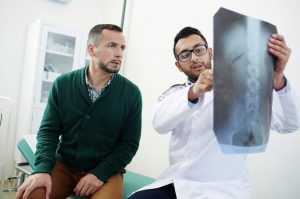Partial Palmar Fasciectomy
A palmar fasciectomy is a surgery to remove all or part of the palmar fascia. This is a thin sheet of connective tissue in your hand. It’s shaped like a triangle. It’s beneath the skin on your fingers and the palm of your hands. Your surgeon cleans the skin, makes an incision, and exposes the palmar fascia. Then they separate it from the nearby tendons and nerves before removing diseased tissue.
Expectations
There are two variations of this treatment: partial and total. If you have a partial palmar fasciectomy, your doctor removes only the abnormal tissue in your affected hand. In a total palmar fasciectomy, your doctor removes all the fascia, even if it’s not causing any problems. Once the surgery’s over, they may close the incision completely. They also may leave a small part open so it can drain.
Before you have the operation, your doctor evaluates your condition to determine how many fingers need treatment. They also decide whether to put you to sleep during the surgery or do it with a local anesthetic that lets you stay awake. This is an outpatient surgery that lasts one or more hours. Most patients go home the same day.
Your doctor wraps your hand with gauze or small bandages after the surgery. You may need to keep your hand elevated and apply ice for the first few days. Physical therapy usually isn’t necessary. Most patients can get back to normal activities within one week.
Reasons for Surgery
Dupuytren’s contracture happens when abnormal tissue forms in the fascia under your palm. That fascia is the connective tissue that holds the skin of your palm in place. The way this condition affects that tissue leaves most patients with the loss of normal hand function. As it gets worse, your doctor may start talking about your surgical options.
There are four types of fasciectomy procedures depending on the severity of the case, they include:
- Enzymatic Fasciectomy (Xiaflex): This nonsurgical but still procedure-based approach uses a chemical enzyme (collagenase – Xiaflex) to dissolve a portion of the diseased palmar fascia (cord) that is causing a finger contracture. It is a two-day approach where day one, the cord is injected. The subsequent day, the hand is numbed and the finger is pulled straight to rupture the cord and lead to a straighter finger. The benefits of this non-surgical approach are that it requires less rehabilitation. The recurrence rate is on average 3-5 years. However, not everyone is a good candidate for this procedure.
- Segmental Fasciectomy: A Short segment of the cord is removed through one or more small incisions along the joint creases. The benefit of this approach is that it is less surgery overall and an easier rehabilitation process. Recurrence rates are around 3 years.
- Regional or Subtotal Fasciectomy: Nearly all of the diseased fascia is removed along with the affected fingers. This involves excising only the fascia that is diseased or affected. In the palm, this includes the pretendinous cords and part of the natatory ligaments. In the finger, the diseased fascia is called spiral and retrovascular cords. The goal of this procedure is to remove as much damaged tissue as safely as possible to prolong the time for regrowth and possible reoccurrence. The recurrence rate is on average 7-10 years.
- Dermofasciectomy: This more aggressive approach is usually reserved for possible recurrent Dupuytrens disease or a more significant, initial involvement. This procedure involves not only excising the diseased palmar fascia but also excising some of the overlying skin. This approach often necessitates skin grafting from a donor site.
A palmar fasciectomy is used to treat more severe cases of Dupuytren’s Contracture. It is more effective than a needle fasciotomy (or needle aponeurectomy) in the long term, and that is why the hand surgeons at Newport Orthopedic Institute no longer offer that procedure. A fasciectomy is considered to be an invasive surgery and can take weeks to months of hand therapy to heal. Hand therapy will usually be required and prescribed by your orthopedic hand surgeon. The purpose of hand therapy is to help you with exercises and movements that will restore the function and movement of your fingers and hands.
Cost
The cost of partial palmar fasciectomy is based on several considerations. This can include both the extent of the procedure and a patient’s insurance carrier. Medicare will cover this surgery if it is deemed necessary treatment. BEST accepts Medicare, most private health insurances, and works with workers’ compensation claims and personal injury cases at all of our centers.
Find Lasting Relief from Partial Palmar Fasciectomy
To learn more about the wide range of treatments for knee injuries and conditions to help you return to an active lifestyle, contact BEST Health System today. Our caring and experienced team of treatment professionals can help you develop a personalized treatment plan that is right for you.
Procedure Doctors
Related Articles
The Seven Benefits of Minimally Invasive Surgery
What is Minimally Invasive Treatment? Minimally invasive surgery is an alternative to traditional surgery that yields better results, quicker recoveries, and fewer hospital visits. This […]
Why You Should Consider a Minimally Invasive Procedure
What is Minimally Invasive Surgery? Prior to medical advancements in the 1980s, traditional procedures, such as open back surgery, were a patient’s only option. Today, […]

